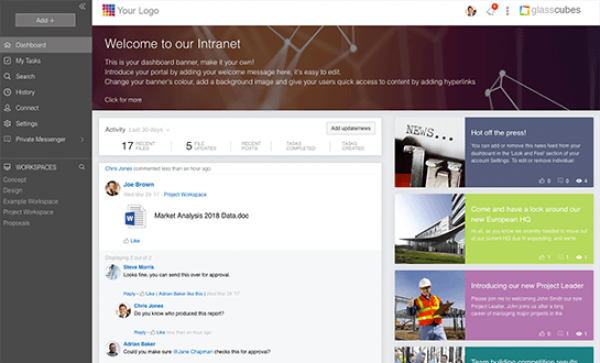External Communication: Real-world Examples & Best Practices
on 22 February 2023
Communication—with both internal and external parties—is the cornerstone of any good business.
It’s the external parties we’re focusing on today because, while communication is important when interacting with employees, it’s especially critical for maintaining good relations with customers and other outside parties.
External communication requires a certain finesse, and you may need to tailor your messages depending on who you’re engaging. Keep reading to see some examples of communication in the real world, and learn the best practices industry experts recommend.
Support your internal and external communication efforts with Glasscubes, the go-to collaboration solution. Request a free demo today.
What is external communication?
External communication is the collection of interactions that occur between an organisation and third parties—customers, clients, suppliers, vendors, academic institutions, business partners, and the media to name a few.
“External communication is critical for businesses,” says Nick Valentino, VP of market operations at Bellhop. “Doing it right helps build relationships with partners, customers, and other stakeholders who are likely to have a significant impact on the company’s success.”
Compare external communication with its sister term: internal communication.
Internal communication is the collection of interactions that occur between an organisation and its employees. Think office meetings, team conference calls, annual town halls, face-to-face conversations, emails, daily instant messages, bulletin board messages, comments on company forums, and so on.
We put together a guide on internal communication you can read once you’ve finished learning about external communication below.
4 External Communication Examples
1. Press Conference
Jonathan Merry, owner of Bankless Times, says one example of external communication is a company holding a press conference to announce a new product. “The company will want to present the product in the best light possible, highlighting its features and benefits while addressing potential concerns or criticisms. It is important to take a strategic approach with this type of communication because how the product is presented can greatly impact how the public perceives it and its success in the market.”
2. Social Media
“Your social media page is an example of external communication,” says Patrick Cohen, CEO of CarCover.com. “The content you post can be advertisements, commentary on relevant industry news, or simply announcements about your company. But always be mindful of taking a strategic approach around your messaging as one mistake can break you, especially in this era of cancel culture.”
3. Press Release
Daivat Dholakia, VP of operations at Essenvia, says doing a joint press release with a business partner falls under external communication. For example, when his company worked together with another business on a project, they partnered to craft a press release to announce the news publicly. “It’s important to take a strategic approach when communicating externally—especially when doing so with another party—because it’s an opportunity to not only leverage each other’s brands and networks but also sets the stage for long-term collaboration.”
4. Vendor Communication
“You’re using external communication when establishing and maintaining your vendor relationships,” says David Zhang, CEO of Kate Backdrop. His company relies heavily on outside vendors for materials, pricing, and other business needs, so the quality and longevity of these relationships are essential to success. “We continually engage in two-way communication—we provide regular updates on our new products and services, and they keep us informed of their latest offerings.”
7 External Communication Best Practices
1. Maintain a consistent brand identity.
Andy Kalmon, CEO of Benny, says it’s important to maintain a consistent brand identity and message when communicating with parties outside your organisation. “Tailor the content for the intended audience to ensure maximum impact, and present your business in the same manner each time to build familiarity.”
2. Provide value in every interaction.
“A common misconception about external communications is that it's just a means for businesses to plaster their name all over town,” says Timothy Allen, senior corporate investigator at Corporate Investigation Consulting. “Even if you’re able to get the word out about your business and its products, that doesn't mean that your target audience will like what they hear or be willing to listen.”
Allen explains that a well-considered strategy that provides value with each communication touch point will open ears and provide stronger outcomes. “Be mindful of what will resonate with your target market and help them address the problems they face.”
3. Be clear and transparent in your messaging.
According to Merry, being clear and transparent in your messaging “includes being upfront and honest about the information you share—avoid misleading or exaggerating the truth. Additionally, it's important to be responsive to any questions or concerns that may be raised by external parties and to be prepared to address them in a timely and professional manner.”
4. Research your audience.
“One best practice with regard to external communication is to research the audience's culture and past experiences, so that communication efforts can be tailored to respect that culture and understand what will be most relevant for them,” says Valentino. “Doing this deeper level of research will help you achieve your communication objectives in a meaningful way for all stakeholders.”
5. Respond quickly to inquiries.
Amy Weiher, creative director at Weiher Creative, recommends replying promptly and professionally when you have a prospect inquire about your services. “How I respond to these inquiries sets the tone for the entire relationship should they become a client.”
Weiher notes that the longer it takes you to respond, the less likely it is that the person will want to work with you. While it's not always convenient to reply quickly, it is important.
“I've found that a quick, simple email inviting the potential client to schedule an appointment for a discovery call with me by sharing my calendar is effective,” Weiher explains. “It takes me less than a minute to reply this way. More often than not, if a prospect schedules that call, they inevitably become a client.”
6. Be concise.
“When it comes to external communications, keep it brief,” says Cohen. “Using fewer words can often help you create a stronger, clearer message. Furthermore, keeping your message short will leave less room for ambiguity since you are forced to use more precise words to communicate your point.”
7. Communicate regularly.
Zhang says being regular with your external communication is key. This means keeping an open line of communication and ensuring that all parties know relevant goals, expectations, and timelines. “This will help to create a healthy dialogue and an efficient process for establishing successful relationships. With regular communication, you can ensure each party is on the same page and working toward a shared goal.”
Support external communication with your clients and suppliers with the right tool.
Working with clients can be a hassle when their team and yours are out of sync. Project delays and miscommunications become frequent issues. The same goes for suppliers—late shipments and inaccurate orders become par for the course.
That’s where a tool like Glasscubes comes into play. Our collaboration solution not only makes work more efficient but also saves you time and keeps both your internal and external communications in one centralised location. Create as many customisable workspaces as you need to share files, assign and manage tasks, and keep everyone up to date on project progress.

Keep your teams on track to success with a collection of value-packed features:
- Store and share files in a secure location, complete with automatic version control. You can even create approval workflows and view clear audit trails of user actions.
- Collect, process, and approve information through customisable, automated forms and workflows that include user assignees, assignee follow-ups, and completion alerts.
- Assign and manage tasks for different members of the team, and track them to completion.
- Create customised workspaces for each project team in your portfolio. Team members can share resources and communicate with one another in their specific workspace, and you can access them all for easy oversight.
User Spotlight
“Glasscubes provides us with an easy to use, flexible platform for collaboration, which works well for both internal use and especially when working with a range of external partners. The ability to enable facilities selectively for different groups and projects means they can have what they need without being distracted by what they don't. Management is straightforward and end users require very little training to make use of the system—and if they do, there's detailed help only a couple of clicks away.”
—Graham Mulholland via Trustpilot
Want to see how other companies are using Glasscubes to make remote collaboration a cinch? Check out these case studies. Or, get started working more productively now by requesting a free demo of Glasscubes.


